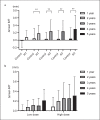Continuous and Early Progression of Carotid Intima-Media Thickness after Radiotherapy for Head and Neck Cancer: 5-Year Prospective Observational Study
- PMID: 36716719
- PMCID: PMC10627489
- DOI: 10.1159/000528622
Continuous and Early Progression of Carotid Intima-Media Thickness after Radiotherapy for Head and Neck Cancer: 5-Year Prospective Observational Study
Abstract
Introduction: Radiation-induced carotid artery stenosis (RI-CS) is known as one of long-term side effects of radiotherapy for head and neck cancer (HNC). However, the clinical time course after irradiation has been poorly understood. We aimed to investigate the natural history of radiation-induced carotid atherosclerosis, comparing the patients who received radiotherapy for HNC with the patients who were treated without radiotherapy.
Methods: The patients who received treatment of HNC at Department of Otolaryngology, Head and Neck Surgery of Kyoto University Hospital, from November 2012 to July 2015 were enrolled. The patients were assigned into the RT group and the control group, depending on whether radiotherapy was planned or not. Annual carotid ultrasound was performed from the enrollment to 5 years. The increase of mean intima-media thickness (IMT) at common carotid artery from the enrollment (Δmean IMT) was evaluated.
Results: Fifty-six patients in the RT group and 25 patients in the control group were enrolled. From 5-year follow-up data, the significant higher increase of Δmean IMT was consistently observed in the RT group than in the control group after 2 years. The RT group presented a 7.8-fold increase of mean IMT compared to the control group (0.060 mm per year in the RT group and 0.008 mm per year in the control group). Cumulative incidence curves obtained from the analysis of all vessels revealed that the RT group presented higher incidence of Δmean IMT ≥0.25 mm than the control group (p < 0.01). In the RT group, the patients with mean IMT ≥1.0 mm at enrollment exhibited significantly higher incidence of Δmean IMT ≥0.25 mm than the patients with mean IMT <1.0 mm (p < 0.01).
Discussion: Radiotherapy for HNC induces continuous carotid mean IMT progression. The irradiated carotid arteries with mean IMT ≥1.0 mm before radiotherapy presented earlier IMT progression than those with mean IMT <1.0 mm.
Keywords: Atherosclerosis; Carotid artery stenosis; Head and neck cancer; Radiotherapy.
© 2023 The Author(s). Published by S. Karger AG, Basel.
Conflict of interest statement
The authors have no conflicts of interest to declare.
Figures


References
-
- Miller KD, Triano LR. Medical issues in cancer survivors: a review. Cancer J. 2008;14((6)):375–387. - PubMed
-
- Oeffinger KC, Mertens AC, Sklar CA, Kawashima T, Hudson MM, Meadows AT, et al. Chronic health conditions in adult survivors of childhood cancer. N Engl J Med. 2006;355((15)):1572–1582. - PubMed
-
- Zhang F, Wang K, Du P, Yang W, He Y, Li T, et al. Risk of stroke in cancer survivors: a meta-analysis of population-based cohort studies. Neurology. 2021;96((4)):e513–e526. - PubMed
-
- Dorresteijn LDA, Kappelle AC, Boogerd W, Klokman WJ, Balm AJM, Keus RB. Increased risk of ischemic stroke after radiotherapy on the neck in patients younger than 60 years. J Clin Oncol. 2002;20((1)):282–288. - PubMed
Publication types
MeSH terms
LinkOut - more resources
Full Text Sources
Medical
Miscellaneous

